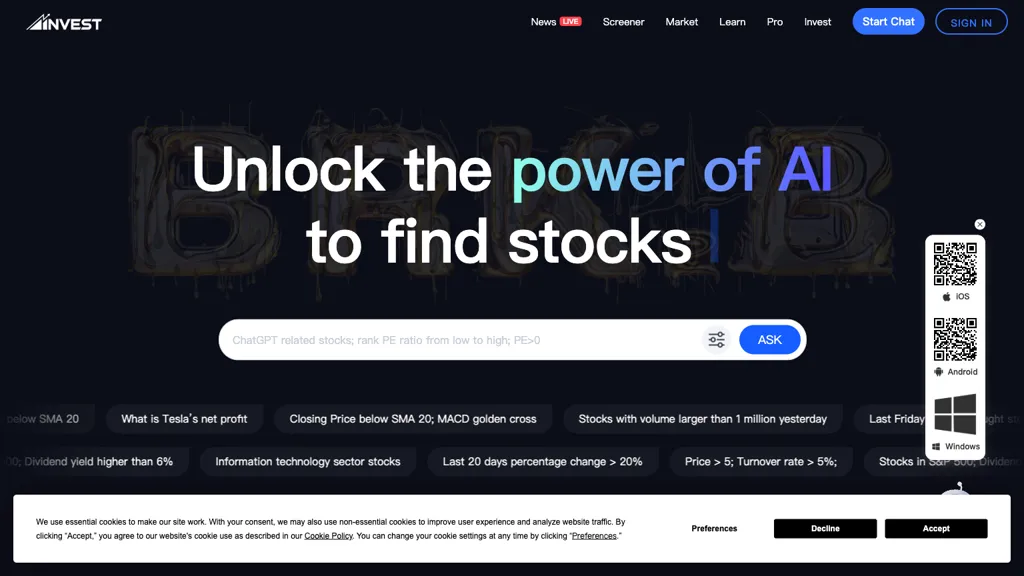20 Pro Suggestions For Picking AI Stock Investing Platform Websites
20 Pro Suggestions For Picking AI Stock Investing Platform Websites
Blog Article
Top 10 Tips To Evaluate Ai And Machine Learning Models Used By Ai Platforms For Analyzing And Predicting Trading Stocks.
It is essential to examine the AI and Machine Learning (ML) models utilized by stock and trading prediction platforms. This will ensure that they provide accurate, reliable and actionable insight. Models that are not properly designed or overhyped can result in financial losses and inaccurate forecasts. Here are 10 tips to evaluate the AI/ML capabilities of these platforms.
1. Find out the intent and method of this model
It is crucial to determine the goal. Make sure the model was designed for long-term investing or for trading on a short-term basis.
Algorithm disclosure: Check whether the platform is transparent about the algorithms it is using (e.g. neural networks and reinforcement learning).
Customization. Determine if the model is able to be customized according to your trading strategy, or your risk tolerance.
2. Review the Model Performance Metrics
Accuracy Verify the model's predictive accuracy. Do not rely solely on this measure, however, because it can be misleading.
Precision and recall: Evaluate whether the model is able to identify real positives (e.g. accurately forecasted price movements) and minimizes false positives.
Risk-adjusted returns: See whether a model's predictions result in profitable trades when risk is taken into account (e.g. Sharpe or Sortino ratio).
3. Test the model using backtesting
The backtesting of the model using previous data lets you test its performance against prior market conditions.
Testing outside of sample The model should be tested using data it wasn't trained on in order to avoid overfitting.
Scenario-based analysis involves testing the model's accuracy under different market conditions.
4. Check for Overfitting
Overfitting Signs: Look for models that do exceptionally well when trained but poorly with data that is not trained.
Regularization methods: Check that the platform doesn't overfit using regularization techniques such as L1/L2 and dropout.
Cross-validation (cross-validation) Check that your platform uses cross-validation to assess the generalizability of the model.
5. Assess Feature Engineering
Relevant Features: Examine to see whether the model includes relevant characteristics. (e.g. volume prices, technical indicators, price and sentiment data).
Selecting features: Ensure that the application chooses characteristics that have statistical significance, and avoid redundant or irrelevant information.
Dynamic feature updates: Verify if the model adapts to the latest characteristics or market conditions over time.
6. Evaluate Model Explainability
Interpretability: Make sure the model provides clear explanations of its predictions (e.g. SHAP value, importance of particular features).
Black-box Models: Be cautious when platforms use complex models that do not have explanation tools (e.g. Deep Neural Networks).
User-friendly Insights: Make sure that the platform offers useful information in a format that traders can easily understand and utilize.
7. Review Model Adaptability
Market conditions change. Check if the model is able to adapt to the changing conditions of the market (e.g. an upcoming regulations, an economic shift, or a black swan phenomenon).
Be sure to check for continuous learning. The platform should be updated the model often with new information.
Feedback loops: Make sure the platform is incorporating feedback from users as well as real-world results to help refine the model.
8. Look for Bias & Fairness
Data bias: Ensure that the training data you use is a true representation of the market and free of biases.
Model bias: Find out if the platform actively monitors and reduces biases in the model's predictions.
Fairness. Be sure that your model doesn't unfairly favor certain industries, stocks or trading strategies.
9. Assess the efficiency of computation
Speed: Determine if your model is able to make predictions in real time or with minimum delay particularly when it comes to high-frequency trading.
Scalability: Determine whether the platform can manage large datasets and multiple users with no performance loss.
Resource usage: Check to determine if your model has been optimized for efficient computational resources (e.g. GPU/TPU use).
Review Transparency, Accountability, and Other Issues
Documentation of the model. Make sure you have a thorough documents of the model's structure.
Third-party auditors: Examine to see if the model has undergone an independent audit or validation by a third-party.
Error handling: Examine for yourself if your software includes mechanisms for detecting and correcting model errors.
Bonus Tips
User reviews and case study User feedback and case study to evaluate the actual performance of the model.
Trial period: Try the model for free to see the accuracy of it and how simple it is use.
Customer support: Ensure the platform offers a solid assistance for model or technical issues.
Follow these tips to assess AI and ML models for stock prediction, ensuring that they are accurate, transparent and aligned with trading goals. See the most popular https://www.inciteai.com/ for more tips including ai for trading, ai investing platform, best ai for trading, stock ai, ai investing platform, ai for stock trading, trading with ai, ai trade, ai for investing, using ai to trade stocks and more.
Top 10 Tips To Evaluate The Educational Resources Of Ai Stock-Predicting/Analyzing Trading Platforms
Examining the educational materials offered by AI-driven stock prediction and trading platforms is vital for users to understand how to make the most of the platform, understand the results and make informed trading decision. These are the top 10 tips to evaluate the quality and value of these resources:
1. Comprehensive Tutorials and Guides
TIP: Check to see whether the platform offers instructions and step-by-step tutorials for beginners as well as advanced users.
Why? Clear instructions will help users use the platform.
2. Webinars with video demonstrations
Search for webinars, video demonstrations, or live training sessions.
Why is that visual and interactive content makes complex concepts simpler to comprehend.
3. Glossary
TIP: Make sure the platform has a glossary and/or definitions for the most important AI and finance terminology.
Why? It helps new users understand the terminology of the platform, particularly those who are new to the platform.
4. Case Studies & Real-World Examples
Tip. Verify that the platform has case studies demonstrating how AI models could be applied to real-world scenarios.
Why: Practical examples demonstrate the effectiveness of the platform and assist users relate to its applications.
5. Interactive Learning Tools
Check out interactive tools like questions, sandboxes, simulators.
Why are interactive tools useful? Interactive tools allow users to learn and test their skills without risking real money.
6. Content is regularly updated
Check if the educational materials are frequently updated to reflect the latest market trends or regulations, new features and/or changes.
Why? Outdated information may cause confusion about the platform, or even its incorrect usage.
7. Community Forums and Support
Search for forums that are active in communities or support groups that allow users to exchange ideas and share insights.
What's the reason? Expert advice and peer recommendations can assist students to learn and solve problems.
8. Certification or Accreditation Programs
Check if it offers accredited or certified classes.
Why? Recognition of formal learning can increase credibility and motivate users.
9. Accessibility and User-Friendliness
Tips: Assess the accessibility and usability of educational resources (e.g., mobile friendly and downloadable pdfs).
Access to content is easy and allows users to study in a way that best suits their needs.
10. Feedback Mechanism for Education Content
Tip: Verify if the platform allows users to give feedback on educational materials.
Why is it important? User feedback is important for improving the quality of the resources.
Bonus Tip: Study in various formats
Be sure that the platform supports different learning formats that can be adapted to different learning styles (e.g. audio, text, video).
It is possible to evaluate these aspects to determine if the AI trading and stock prediction platform provides high-quality educational materials that can help you maximize its capabilities and make educated trading choices. Check out the top rated ai stock trader info for website tips including invest ai, best ai trading platform, best ai stocks to buy now, ai stock investing, best ai penny stocks, ai stock investing, best ai stocks to buy now, ai share trading, free ai tool for stock market india, ai in stock market and more.